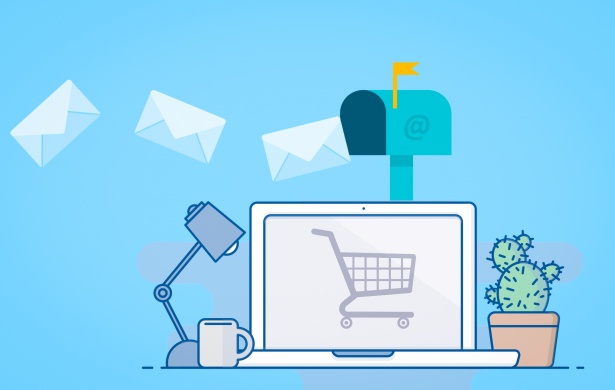As eCommerce takes up an ever-growing slice of the retail market, brands are funneling more resources into improving their digital marketing strategies, personalizing customer experiences, and creating custom user interfaces.
Let’s take a closer look at some eCommerce stats that are changing the customer experience (CX) landscape.
Key eCommerce Statistics to Inform Brands’ Strategies in 2020
- The share of eCommerce on U.S. retail sales has grown from 4.6% in 2010 to about 10.7% in 2019.

- Pages that take five seconds to load have a 90% bounce probability.
- Amazon Alexa’s estimated smart speaker market share in the U.S. is at 58%, followed by Google Home at 28%.
- Survey respondents who have been served a highly personalized eCommerce shopping experience are 110% more likely to buy additional products.
- Stores that use at least one social media (Facebook/Twitter) have 32% more sales than businesses without one.
- Before their in-store purchases, Gen Z shoppers saw a social media ad (30%), checked customer reviews (34%), saw the brand on Amazon (36%), and browsed the company website (37%).
The rising importance of omnichannel marketing, personalization, and consumer experience is prompting companies to find systems that will enable them to keep up with tech developments and meet client expectations. One solution that fits the bill is headless commerce.
What Is Headless Commerce?
Headless commerce is basically a decoupling of your website’s front end (client side or user interface) from the back end (server side or background operations). Going headless enables businesses to power their sites with a combo of content management systems (CMS), customer relationship management solutions (CRM) tools, and eCommerce platforms that suit their business goals and customer preferences.

Source: https://www.plytix.com/blog/headless-commerce
More and more companies are moving toward headless solutions and away from traditional eCommerce platforms for several reasons:
- Greater flexibility: Headless commerce eliminates the design and customization constraints often found in traditional platforms. This allows businesses to build and experiment with different designs or user interfaces.
- Better customer experience: Companies using traditional eCommerce have to make do with limited CX options, while those who go headless are able to deploy tailored user experiences.
Moreover, when new channels or technologies emerge that fit their business or client needs, companies can simply merge these into their existing architecture using API.
- Lower risks: Divorcing the user interface and back-end processes frees up brands to change the frontend or build a new online store without having to alter the code or database.
- Rapid deployment: Because changes in the presentation layer no longer require alterations on the server side, companies can roll out front-end modifications much faster, taking days to a few weeks instead of months.
- Faster site speed: Separating the user interface from the eCommerce functions and getting rid of unutilized features boost site speed, helping improve conversions.
So, How do you Maximize Headless Commerce to Increase your Traffic, Conversions, and Sales?
#1. Leverage Its Seamless Integration
Headless commerce positions you to maximize the Internet of Things (IoT). Through its seamless integration features, you can quickly and easily take advantage of any and all touchpoints, channels, and systems that will bring you in front of your target customers.
This can be through smart devices, your website, email, social media, mobile apps, or third-party sites. You can leverage APIs to distribute data to any device, then come up with unique front-end features and web designs to provide the best CX for each touchpoint.

Source: https://www.smartinsights.com/ecommerce/ecommerce-strategy/case-headless-commerce/
Because you are not tied down to one platform, and your frontend and backend processes are separate, you have endless opportunities to customize your content and user interface, and keep up with digital marketing trends without waiting for months or causing unwanted backend changes.
#2. Use It for Better, Faster Personalization
The success of any business in the eCommerce space does not lie solely on how fast they can adapt to technological trends but how well they can align their strategies to their customers’ needs and preferences.
Headless eCommerce makes personalization easier for companies in multiple ways. For instance, retailers expanding to new territories can easily integrate the preferred payment methods in the region without having to replatform, interrupt established payment systems, or wait for their eCommerce platform to incorporate additional gateways.
Also, with your backend system linked to multiple channels and devices, you can give your buyers more personalized suggestions based on purchases and subscriptions they’ve made on other platforms. Finally, you can do better than suggesting items other people bought or viewed. Using backend data, you can customize offers and frontend features to better meet a repeat client’s preferences, profile, and transaction history, translating to a better customer experience.
#3. Unify Content and Commerce
With headless solutions, B2Bs with content-rich sites no longer have to move all their materials when they diversify their offers to include ecommerce. They can simply link their current CMS with their preferred eCommerce solution.
Headless commerce also enables companies who have been running their content (such as blogs, white papers, product details, and videos) and eCommerce in different sites to integrate these. They can customize their front end while keeping unified information in their back end.
#4. Maximize Agile Marketing
Agile marketing requires companies to quickly use data to identify trends and opportunities, run tests, evaluate, and improve their design, approach, or system. Separating frontend from backend systems has allowed businesses, especially their marketing teams and web designers to experiment and deliver results swiftly.
Revamping an existing eCommerce system to catch up with emerging marketing technologies and trends can take months, as developers need to modify the back end each time frontend changes are made. But with headless marketing, you can simply integrate new tools into your system, and your teams can start developing and experimenting with new marketing channels and customer experiences in a matter of days.
By saving companies time and costs, boosting their speed-to-market, and enabling them to iterate fast, use more advanced tools, and further personalize their offers, headless commerce is helping brands stay ahead of the competition.
#5. Nurturing Customers Using Omnichannel Strategies
Today’s buyers are shopping online using multiple channels. They may stumble upon your product on YouTube ads, see a sponsored post on Facebook, go to your website, subscribe to your newsletter, and only buy from you after you run an email marketing campaign.
As your buyers go omnichannel, so must your company. You need to identify the channels used by most of your target or current customers and develop a strong presence in these.
As new channels arise and get their share of audiences, headless commerce lets your company pivot quickly and share content, market, and sell on these emerging platforms using APIs. For instance, aside from your website, apps, social media channels, and third-party platforms, you can include voice assistants and smart watches and home devices. With this setup, your teams only need to design customer experiences for emerging channels while pulling product and customer information from a unified backend.
Deploying an omnichannel strategy keeps you top-of-mind for your target audience and fires up their interest until they’re ready to buy from you. Moreover, it gives you multiple ways to keep in touch with and present offers to your past or existing clients.
Omnichannel retail benefits your customers too. They can conveniently purchase your products or services from the channel they’re using at that exact moment. If you’ve integrated your system with popular payment methods in their country, you also enable them to choose their preferred gateway instead of limiting them to solutions built into traditional platforms.
#6. Provide a Consistent CX
A consistent CX goes beyond using similar colors, fonts, and designs across channels to achieve a stronger visual branding. A seamless user experience also includes functionally consistency. For instance, functions like search or content navigation need to be the same whichever device your visitor is holding. Such predictability allows your audience to easily navigate your content or feel more comfortable browsing your apps, increasing the time they spend on your site and the chances that they will buy from you.
With headless commerce, you can continue to improve your user interface features and storefronts to match your brand’s values or latest visuals without revamping or jeopardizing your eCommerce setup.
Bonus Tip: Get Your Product Information Management (PIM) System Ready Before Going Headless
Especially if you have an extensive inventory, you’re going to need a place where you can lodge your product information so these can be conveniently pulled out by your marketing, sales, and technical teams. This is where a product information management (PIM) system comes in handy.
Your PIM software serves as a repository of all your product information, including dimensions, warranty, images, bundles, technical description, and marketing content. By drawing materials from a centralized source, you can provide your site visitors with consistent, accurate, and extensive product details whichever channel or device they use. This translates to improved user experience and, when prospects get all the information they need, they can move along faster down the sales funnel and closer to making a purchase.
Stores That Have Been Leveraging Headless Commerce
Burrow
The furniture store has been using a headless CMS to give online buyers an exceptional omnichannel experience.

Source: https://burrow.com/nomad-leather/loveseat-chaise-ottoman?sku=NLSCO-TN-2-HI-CM
Carluccio’s
The Italian restaurant chain combines WordPress and BigCommerce’s WP plugin to create a stunning, content-rich site.

Source: https://www.carluccios.com/menu/?rest=
Koala
Opting for headless commerce allowed this Aussie furniture retailer to offer a tailored experience, such as per device or customer segment, and improve the site’s response time. Moreover, they can quickly deploy changes and even simultaneously make frontend and backend changes.

Koala’s Help page on desktop enumerates questions per topic, while the mobile version only shows the main query themes.
Koala relies on ShopifyPlus for its checkout and storefront, and uses multiple providers for other functions such as analytics and reporting, CMS, inventory, logistics, and discounting and promotions.

Source: https://www.shopify.ca/enterprise/headless-commerce-is-flexible-commerce
Going Headless Is the Future of Ecommerce
New technologies and strategies are being released all the time, and these will continue to change the way people shop and how brands market their products or grow their businesses.
Headless commerce allows forward-thinking companies to quickly adapt to current and future trends and maximize emerging opportunities to ensure their long-term success. It will give them the flexibility to create consistent, immersive CX across established and new platforms. Their teams, too, are able to rapidly integrate new tech solutions that will streamline internal processes, improve marketing strategies, and ultimately benefit the company’s bottomline.
Is your company exploring headless commerce? What’s prompting you to consider this option? What’s holding your team back from going headless?















